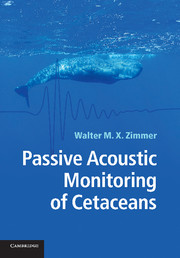Book contents
- Frontmatter
- Contents
- Acknowledgements
- Introduction
- Part I Underwater acoustics (the basics)
- Part II Signal processing (designing the tools)
- Part III Passive acoustic monitoring (putting it all together)
- 7 Applications of passive acoustic monitoring
- 8 Detection functions
- 9 Simulating sampling strategies
- 10 PAM systems
- References and further reading
- Index
9 - Simulating sampling strategies
Published online by Cambridge University Press: 26 April 2011
- Frontmatter
- Contents
- Acknowledgements
- Introduction
- Part I Underwater acoustics (the basics)
- Part II Signal processing (designing the tools)
- Part III Passive acoustic monitoring (putting it all together)
- 7 Applications of passive acoustic monitoring
- 8 Detection functions
- 9 Simulating sampling strategies
- 10 PAM systems
- References and further reading
- Index
Summary
This chapter introduces computer simulation as a technique to emulate real-world PAM and should demonstrate that simulations are useful not only to generate data, but also to analyse the system's performance.
PAM is really a field effort where one takes a single hydrophone or an array of hydrophones, embarks on a boat or ship, moves over the oceans in a hopeful, well-planned way and collects data to detect the presence or assess the absence of acoustically active whales and dolphins.
Simulation implies experimentation also, but instead of using a real-world PAM system, we use a computer and experiment with a model of the PAM application. The term model in this context means that we deal with a simplified description of the real-world system, where the simplifications are in general made to allow easy discussion of the result. The distribution models for whale depth, pitch and heading, presented in Section 8.5.1, are such simplifications. Similar to real-world applications, computer simulations will generate different results each time they are executed.
Using models as a substitute for real-world systems has a consequence that the results are only indicative of real-world results. If our model parameters are not a reasonable characterization of the real-world system, then we should not expect the simulation results to be realistic.
- Type
- Chapter
- Information
- Passive Acoustic Monitoring of Cetaceans , pp. 274 - 298Publisher: Cambridge University PressPrint publication year: 2011



